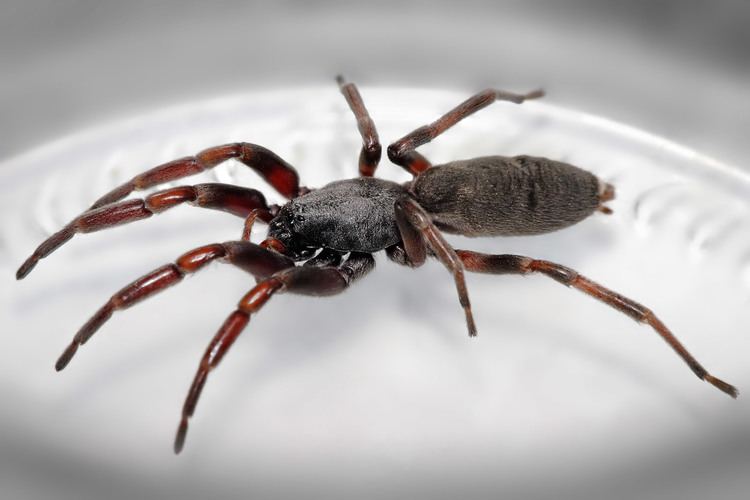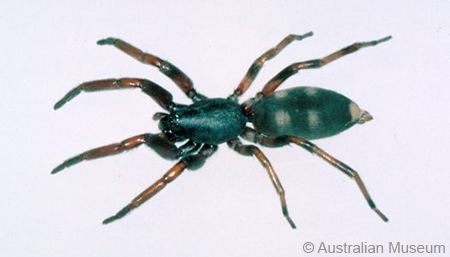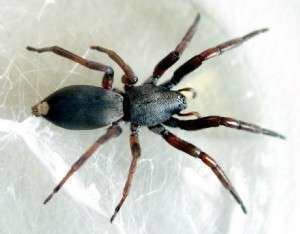Order Araneae | ||
Representative species Lampona cylindrata, Lampona murina | ||
Redback spider vs white tailed spider pray for gonzo deadly spiders attack week 5
White-tailed spiders are spiders native to southern and eastern Australia, and so named because of the whitish tips at the end of their abdomens. Body size is up to 18 mm, with leg-span of 28 mm. Common species are Lampona cylindrata and Lampona murina. Both these species have been introduced to New Zealand.
Contents
- Redback spider vs white tailed spider pray for gonzo deadly spiders attack week 5
- Taxonomy
- Description
- Distribution
- Habitat and behaviour
- Bites to humans
- References

White-tailed spiders are vagrant hunters that seek out and envenom prey rather than spinning a web to capture it; their preferred prey is other spiders.

They are reported to bite humans; effects include local pain, a red mark, local swelling and itchiness; rarely nausea, vomiting, malaise or headache may occur. Ulcers and necrosis have been attributed to the bites, but a scientific study by Isbister and Gray (2003) showed these had other causes, mostly infections. A study of 130 white-tailed spider bites found no necrotic ulcers or confirmed infections.

Taxonomy

Ludwig Carl Christian Koch described Lampona cylindrata in 1866 and Lampona murina in 1873. The genus name comes from the Greek lampo which means shine. The species name cylindrata refers to the cylindric body shape, while murinus means "mouse-gray" in Latin.
Description

The two common species of white-tailed spiders are Lampona cylindrata and Lampona murina. They are similar in appearance; L. cylindrata is slightly larger with females being up to 18 mm long while males are up to 12 mm in body length. The legs span approximately 28 mm. The two species are not easily distinguished without microscopic examination. They are slender spiders with dark reddish to grey, cigar-shaped body and dark orange-brown banded legs. The grey abdomen has two pairs of faint white spots and—usually but not always—a distinct white spot at the tip just above the spinnerets.
The similarities have led people to think there is only one species of white-tailed spider. It is possible that not all white-tailed species have been identified. The descriptor, white tail, is applied to a variety of species of spiders for which a distal white mark on their abdomen is a distinctive feature; other markings disappear with moultings but the white tail remains to adulthood.
L. cylindrata lay pinkish eggs which are enclosed in a flattened silk capsule and are guarded by the female until they hatch.
Distribution
Both species are native to Australia. Lampona cylindrata is present across south-east Queensland, New South Wales, Victoria, South Australia, Tasmania and Western Australia while Lampona murina is found in eastern Australia from north-east Queensland to Victoria. The spiders have been introduced in New Zealand with Lampona murina residing in the North Island for over a hundred years while Lampona cylindrata has become widespread throughout the South Island since 1980.
Habitat and behaviour
They live in gardens and inside houses, beneath bark and rocks, in leaf litter and are often found in the folds of clothes, towels and shoes. They do not build webs. Most active at night, they hunt for other spiders. Their favoured prey is either the black house spider or the closely related brown house spider (Badumna longinquus), both of which are, like the whitetail, native to Australia but have been inadvertently introduced to New Zealand.
Bites to humans
A common perception is that white tail spider bites can be associated with long term skin infections, and in rarer cases progression to necrosis. This is an attribution of infections presenting to medical care with a complaint of "spider bite." Venom has no bacteria and infections do not arise from spider bites. The well-described brown recluse bite is direct damage to skin and tissue. It has a limited area and does not spread. No formal studies have found evidence for associating necrosis with white tail spider bites.
White tail spider bites may cause a small red or discolored bump that burns or itches, similarly to an insect bite.
A debate continues about the involvement of white-tailed spider bite in cases of severe ulcerative skin lesions seen in patients diagnosed as probable spider bite victims. Typically, in such cases no direct evidence of spider bite is available. Sensational media reporting of supposed cases of severe "necrotising arachnidism" has given the white-tailed spider a bad reputation - See more at: http://australianmuseum.net.au/White-tailed-Spider#sthash.5lPlRXUa.dpuf
The issue of necrosis in some bite cases in published studies begins with a paper presented at the International Society on Toxinology World Congress held in Brisbane in 1982. Both the white-tailed spider and the wolf spider were considered as candidates for possibly causing suspected spider bite necrosis in the Australian context. In Brazil the recluse spider was identified as linked to necrosis.
Following this initial report, numerous other cases implicated white-tailed spiders in causing necrotic ulcers. All of these cases lacked a positively identified spider — or even a spider bite in some cases. Additionally, there had not been a case of arachnogenic necrosis reported in the two hundred years of European colonisation before these cases. Of the 130 cases of white tail spider bites studied by Isbister and Gray, more than 60% reported that the person had been bitten by spiders that had got into clothing, towels or beds.
Clinical toxicologist Geoffrey Isbister studied 130 cases of arachnologist-identified white-tailed spider bites, and found no necrosis or confirmed infections, concluding that such outcomes are very unlikely for a white-tailed spider bite. The major effects from a bite in this study were local (pain, a red mark, local swelling and itchiness); and rarely systemic (nausea, vomiting, malaise or headache). All these symptoms are generally mild and resolve over time.
